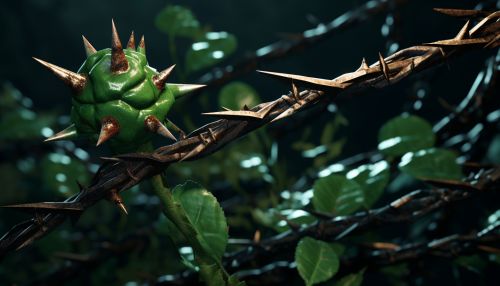Constitutive Defense
Overview
Constitutive defense is a term used in the field of ecology and evolutionary biology to describe the innate, or pre-existing, defense mechanisms that an organism has against predators, pathogens, or other threats. These defenses are always present, regardless of whether a threat is imminent or not. They are contrasted with induced defenses, which are only produced or activated in response to a specific threat or stimulus.


Characteristics
Constitutive defenses are characterized by their constant presence in an organism. They do not require a specific stimulus or threat to be activated. This is in contrast to induced defenses, which are only activated in response to a specific threat or stimulus. Constitutive defenses can be physical, chemical, or behavioral in nature.
Physical Defenses
Physical constitutive defenses are perhaps the most visible and easily recognized. These can include structures such as thorns, spines, or hard shells that deter predators. For example, the thorns on a rose bush or the hard shell of a turtle are constitutive defenses that are always present, regardless of whether a predator is nearby.
Chemical Defenses
Chemical constitutive defenses involve the production of toxic or deterrent substances that discourage predation or infection. These substances can be present in the organism's tissues, or they can be secreted onto the organism's surface. For example, many plants produce toxic compounds that deter herbivores, and some animals produce toxic secretions as a defense against predators.
Behavioral Defenses
Behavioral constitutive defenses involve behaviors that are constantly exhibited by an organism to deter threats. These can include behaviors such as hiding, fleeing, or aggressive displays. For example, many prey animals have evolved to be constantly vigilant and ready to flee at the first sign of danger.
Evolution of Constitutive Defenses
The evolution of constitutive defenses is driven by the selective pressures exerted by predators, pathogens, and other threats. Organisms that have effective constitutive defenses are more likely to survive and reproduce, passing on the genes for these defenses to their offspring. Over time, this can lead to the evolution of increasingly effective and specialized constitutive defenses.
Costs and Benefits
While constitutive defenses can provide significant benefits, they also come with costs. These can include the energy and resources required to produce and maintain these defenses, as well as potential trade-offs with other traits or functions. For example, a plant that invests heavily in producing toxic compounds may have less resources available for growth or reproduction.
